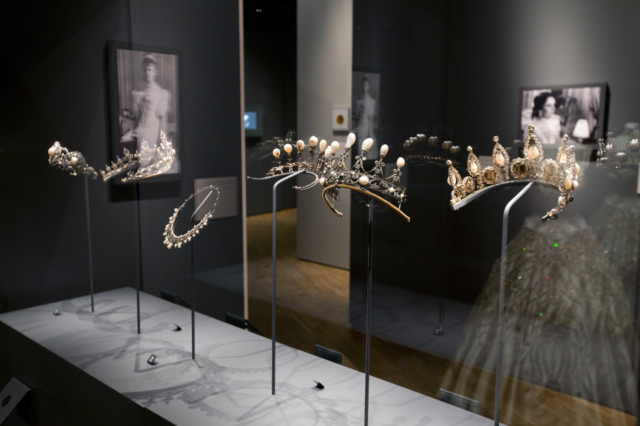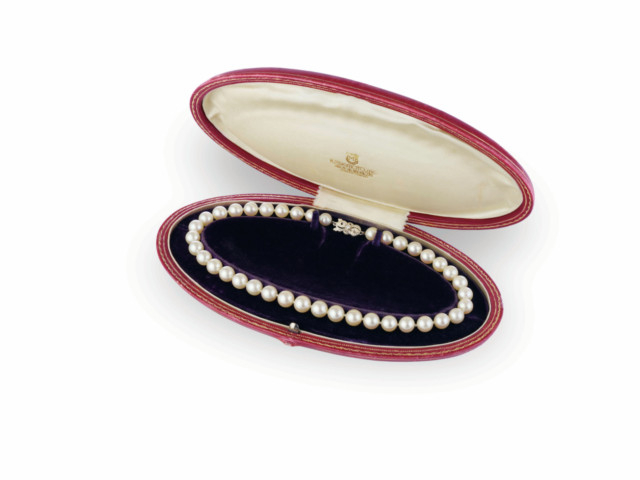
“All art is autobiographical; the pearl is the oyster’s autobiography,” said the Italian film director Federico Fellini. Right now there are hundreds of “pearl autobiographies” on show at the Victoria and Albert Museum (V&A) in London. This truly stunning exhibition, organised in partnership with the Qatar Museums Authority (QMA), has been co-curated by independent jewellery historian and curator Beatriz Chadour Sampson and Hubert Bari, director of a future Pearl and Jewellery Museum at QMA. “Pearls” is part of the events programme for Qatar UK 2013 Year of Culture.
The jewellery and works of art in the exhibition are drawn from the V&A and QMA’s collections, alongside objects from British collections including Tate Britain, the British Museum and the Royal Collections and established jewellery houses such as Mikimoto, Tiffany & Co, Bulgari, Cartier, Chaumet, Rene Lalique and YOKO London.
Each of the beautiful pieces on show has its own special allure and history. What is clear is that pearls have, for centuries, been cherished by many cultures and their appeal seems universal.
It is hard to talk about a few pieces from such a rich collection because each one is exceptional, but here is just a taster.
There is the stunning Dagmar necklace in gold, silver, enamel, diamonds and pearls, lent by Her Majesty Queen Elizabeth II. This necklace was a wedding gift to Princess Alexandra from King Frederik VII. Also on show is a beautiful Norman Hartnell evening gown worn by the queen on a state visit to Paris in 1957. The pearl embroidery with mother of pearl and diplomatic choice of motifs including the Fleur-de-lis, the French Royal emblem, was intended to compliment the host nation.
The Mary Queen of Scots necklace (1572) has a poignant story attached to it. It is said to have been given by the young Queen as a token of love to Thomas Howard, fourth Duke of Norfolk, on the occasion of their engagement.
Queen Elizabeth imprisoned Howard in 1569 for scheming to marry her cousin Mary. Following his release, it is alleged that he participated in the Ridolfi plot with King Philip II of Spain to put Mary on the English throne and restore Catholicism in England. He was executed for treason in 1572. He is buried within the walls of the Tower of London.
This historic piece in gold, enamel and Scottish freshwater pearls has been lent to the exhibition by His Grace, the Duke of Norfolk, Arundel Castle.
It is hard not to feel a shudder of fear when gazing at the single Pearl Drop earring worn by Charles I at his execution in 1649. This haunting piece in gold, enamel and pearl comes from a private collection.
Of course pearls are associated with glamour, and great Hollywood beauties such as Elizabeth Taylor and Marilyn Monroe have pieces of their personal jewellery on show.
The Akoya necklace given to Monroe by her husband Joe DiMaggio during their honeymoon in Japan in 1954 is truly beautiful; an Associated Press picture of the actress wearing the piece is remarkable for revealing her natural, fresh-faced beauty and her preference for understated jewellery quite distinct from her glitzy screen-goddess image.
After Monroe and DiMaggio divorced, she continued to wear the necklace saying it reminded her of happy times. Monroe later gave the necklace to her friend Paula Strasberg, wife of her acting coach Lee Strasberg. When Monroe died in 1962, Strasberg gave the Akoya pearl necklace to her daughter Susan.
Elizabeth Taylor is of course celebrated for her passion for jewellery. On display is a pair of Bulgari natural pearl earrings with platinum and diamonds given to her by her friend and attorney, Aaron Fisher.
An exquisite Chinese imperial robe gives an insight into the value placed on pearls by this ancient culture. In imperial China, pearls were only permitted to be worn by the immediate imperial family, the emperor, empress or empress Dowager.
Catherine the Great (1729-1796), understood the political significance of upholding Russian traditions such as wearing the Kokoschnik (headdress) embroidered with pearls.
Mohammad Ali Khan, Nawab of Arcot (1749-1795) is shown in a portrait festooned with pearl necklaces and armlets and with pearls embroidered on his coat, belt and turban.
The Pearl of Asia is exceptionally large and has a silvery sheen. By tradition, it is thought to have been purchased in India and to have entered the Mogul court of Shah Jahan (ruled 1638-1658). The pearl is then linked to Nadir Shah, King of Persia (ruled 1736-1747) and later the Qianlong Emperor of China (ruled 1735-1796).
Qianlong died on February 7, 1799, and was buried in a tomb, situated to the northeast of Beijing, called Yu-ling. The Pearl of Asia gifted by Nadir Shah, remained a valuable possession of Emperor Qianlong throughout his long reign of 60 years. The emperor as well as his subjects believed that the rare and valuable pearl brought happiness and good fortune. Thus, when the emperor died, the lucky pearl was placed in his tomb. One year after the burial, grave robbers stole the pearl which disappeared before re-surfacing again in Hong Kong. It was subsequently taken to Paris and sold to an anonymous private collector from Europe. It appears that the pearl was set in its present “bunch-of-fruits” setting only after its arrival in Europe.
This unusual piece in gold, jadeite, pink sapphire, pink tourmaline, opals, natural salt water blister pearls and natural baroque pearls is from the collection of His Excellency, Mohammad Mahdi Al Tajir, courtesy of Christies.
The Gulf region had produced some of the world’s finest natural pearls since ancient times. The Greek historian Pliny in his book “Historia Naturalis”, referred to the high quality of the Gulf pearls in the following terms : “But the most perfect and exquisite pearls of all others, be they that are gotten about Arabia, within the Gulf.”
A fabulous necklace with seven graduated strands of natural Gulf pearls with a platinum clasp is just one of the outstanding pieces on show from the QMA collection.
Present at the preview was Michael Hakimian, Chief Executive of YOKO, London. In the 1700s, his ancestors were crown treasurers to Emperor Nadir Shah of Persia. They were charged with caring for the magnificent jewels which the Shah brought back after his invasion of India. Hakimian is absolutely passionate about pearls and travels the world to find the finest examples, especially those of exceptional and unusual colour, used to form the centre pieces of YOKO creations.
His designs are much sought-after and he has a loyal following in the Middle East. YOKO makes custom-made pieces for many clients in the Gulf, particularly for weddings or special occasions. On an average, prices range from $100,000 (Dh367,300) to $300,000 but a unique masterpiece could go as high as one million dollars.
Finding great pearls is no easy task, he explained. “It has always been very difficult to find superb quality because by nature out of every ten thousand pearls maybe just one is good enough to be called superb. Nature is in charge. You cannot tell an oyster what you want or how big or how beautiful you want the pearl to be!”
Emma Clarke of Mikimoto said that headpieces for weddings in pearls and diamonds are especially in demand from Middle East customers. A custom-made piece can take up to a year to make and where price is concerned, she said, “The sky is the limit.”
A showstopping piece is Mikimoto’s “scarf” of 5,000 cultured pearls from the Akoya oyster, each pearl perfectly matched in size and lustre, and set off with diamonds. This wouldn’t keep out the cold but it would certainly stop the traffic!
Mikimoto Kokichi was a true pioneer, building up his business from scratch. The eldest son of an udon shopowner in Toba, Shima Province (present-day Mie prefecture), he left school at the age of 13 and sold vegetables to support his family. Seeing the pearl divers of Ise unloading their treasures at the shore in his childhood started his fascination with pearls. He is credited with creating the first cultured pearl and subsequently starting the pearl industry with the establishment of his renowned luxury company.
The trade in pearls played an important role for places along the coast from Saudi Arabia to Dubai, especially Bahrain and Qatar. Seafaring Arab merchants travelled across the Indian Ocean as early as the seventh century, stopping at various ports along the coasts of India and trading with pearls. Merchants from China travelled to India to acquire the highly prized natural pearls from the Gulf, while at the same time Arab merchants expanded their trade network to Southeast Asia.
By the early 19th century, the Arabian Gulf was the major global supplier of natural pearls. Demand reached unprecedented heights as high-quality “oriental” pearls were much sought after by the great jewellery houses of Europe. The golden age of Gulf pearls was between 1850 and 1930. Today the natural pearl has become a rare gem.
Film material, shot during the last pearling expeditions off the coast of Qatar in the early 1970s, shows the process of harvesting natural pearls. It reflects the hard reality of the work. Because fresh water was so precious on the pearling boats, it could not be used to wash salt off the skin — so the divers spent months covered with salt.
In the East and the West, tastes in jewellery may vary but the significance of pearls remains the same — a symbol of power and an indicator of rank in society. They were much revered objects of desire due to the rarity of natural pearls.
Rulers wore crowns adorned with pearls to demonstrate dynastic authority and the prosperity of their land. In Russia, Iran, China and India, ostentatious displays of pearls formed an integral part of the regalia of ruling monarchs.
In Europe, royal and aristocratic women wore rare pearls mounted on splendid tiaras to dazzle and impress. As old social conventions were overturned, pearls adorned the necklines of ladies of fame and fortune. The screen legends of Hollywood films and, more recently, fashionable, media-friendly celebrities have helped to uphold the unfailing glamour of pearls.
Jewellery design experienced great changes during the second half of the 20th century. During the 1960s and 1970s avant-garde jewellers in Europe broke away from traditional gem-set jewellery to create abstract sculptural designs with unconventional settings for pearls. In contrast, the high-end jewellers sought a path between tradition and modernism. From 1980s, the emphasis of artist and jewellers has been less on the value of the pearl and more on the novelty of design. Searching for new ways of wearing pearls, they set them in a variety of metals, often with textured surfaces and successfully combined them with non-precious materials.
Today, the range of aesthetics in pearl jewellery is boundless and the variety of pearls quite remarkable. Whether natural, cultured or imitation, pearls continue to be fashionable and are being worn by increasing numbers of women. Pearls are a symbol of femininity and timeless jewels befitting any event or occasion.
The V&A exhibition gives a wonderful overview of the history and design evolution of pearl jewellery. Martin Roth, director, Victoria and Albert Museum, explained that the V&A and Qatar Museums Authority have a “long and outstanding cooperation” and exchanges in terms of conservation and objects.
Miguel Bianco Carrasco, director of Strategic Cultural Relations — Office of HE — chairperson, said: “The Qatar Museums Authority is thrilled to collaborate with the V&A on this truly remarkable exhibition. Creating lasting partnerships between institutions that encourage dialogue and cultural understanding is one of the fundamental objectives of the Qatar UK 2013 Year of Culture. This exhibition is a great example of this, bringing together two great Qatari and UK organisations.”
Denise Marray is an independent writer based in London.
Pearls, which is sponsored by Qatar Shell, is on at the Victoria and Albert Museum, London, until January 19, 2014.





